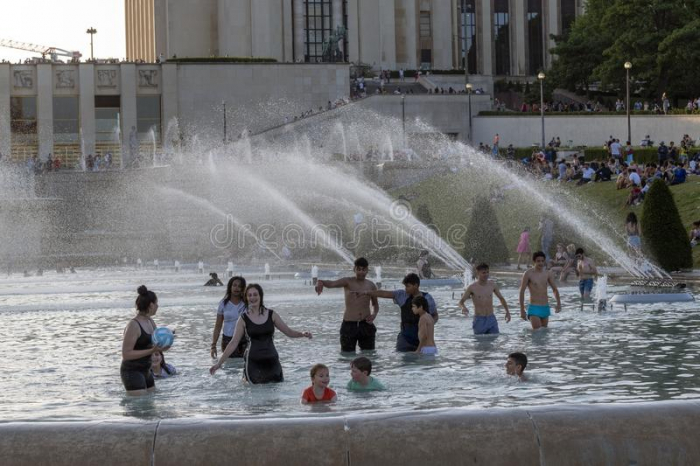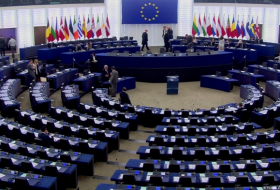By the end of the century, three-quarters of the world could be at risk of deadly heat. And yet, we still struggle to design cities to be heatwave ready.
Jennifer Walker spends most of her life on the pavement – which is scorchingly hot in Los Angeles's San Fernando Valley. For the past six months, she's lived out of a tent next to a large shop, surrounded by bags of food, clothes, and many bottles of water. When it gets too hot, she'll sit inside the covered car park, or use the battery-powered fan inside her tent.
The heat is oppressive, but Walker is cheerfully thinking about how much worse the climate could feel. And given her lack of good indoor housing options, "I'm going to stay outside," she says.
It's grimly clear that due to human-induced climate change, heatwaves are becoming more frequent and intense – and affecting many more people than those who live on the streets, like Walker. Presently, 30% of people worldwide are at risk of potentially deadly heat exposure for over 20 days a year. Depending on the rate of human-induced climate change, that proportion could reach 74% by 2100.
The good news is that there is a bevy of simple ways to combat health risks from heat.
One of the most important aspects is the most basic: simply recognising that high temperatures are a problem.
Because heat is a slow-moving, gradually accumulating disaster, its effects can be invisible. Heat is one of the biggest weather-related killers, but no one knows for sure just how many lives it claims. It isn't always mentioned as a factor in death certificates, so coroners and medical professionals can't grasp the full scale of heat as a health hazard.
In many places, heat continues to be perceived largely as a blessing, rather than as a threat. For instance, Japanese cities have a custom of competing with each other for the title of "hottest city in Japan". This can be a lucrative tourism slogan, but risks understating the dangers of heat-related illnesses – something that should be painfully clear in Japan, where over 1,000 people died in a heatwave in 2018.
Earlier and more effective public health warnings can challenge the underestimation of heat risks. In Ahmedabad in India, early heat warnings have been sent to people's phones via WhatsApp, as part of a package of measures that have been found to effectively increase awareness of the risks of heatwaves. Meanwhile, state-appointed "heat officers" in Florida have called for a naming system for heatwaves, similar to that used to name hurricanes.
Technology may help. Jennifer Runkle, an environmental epidemiologist at the North Carolina Institute for Climate Studies, researches the emerging field of wearable sensors to track body temperature and signs of heat strain. "We're really interested in how to use this technology to promote sustained engagement in and response to heat warnings," she explains. "One way to protect against dismissal or inaction is to incorporate these data into electronic health records, and… encourage health providers and support partners to inquire about these data during routine care visits."
Although messaging is important, how those messages are delivered matters. Too frequent warnings, or confusing colour coding, can result in people ignoring advice. Adding more warnings might not have the intended results.
"The real challenge isn't the warning systems, but the behaviour change," according to Public Health England consultant Emer O'Connell.
And that's if people actually encounter the risk advisories. Older and less-educated people are less likely to receive heat warnings.
The elderly make up the majority of people at risk of heat stress. Yet despite being the most vulnerable group, many don't consider themselves in danger. In the UK, the homes of over-75s are more prone to overheating, but these residents are less likely to report overheating. Similarly, a French study found that only 4% of people surveyed in the 65-and-over age group considered themselves at high risk during heatwaves.
There are good reasons for this disconnect. Certain medications and health conditions can make it hard to determine body temperature, and to respond swiftly to the dangers. The symptoms of heatstroke – including confusion, cramps and fatigue – can be hard to differentiate from other medical conditions, including Covid-19. Cognitive impairment adds another challenge, as does resistance to changing habits.
The dismissal of heat risks isn't just about individuals. Among policymakers in some places, there's a bias toward cold management rather than heat management, and towards addressing more spectacular climate-linked events like floods.
Even in Japan – which is so prepared for emergencies that there's a national Disaster Prevention Day, and where many institutions regularly carry out disaster drills – disaster prevention education programs don’t always incorporate excessive heat.
One of the most important action areas to reduce soaring temperatures is to increase green space in cities, from roofs to parks. Urban greening works to combat heat, says Gerardo Sanchez Martinez, an environment and health expert at the European Environment Agency. Yet all too often, urban management isn't fully implemented as part of heat-health action plans.
Admittedly, tree planting is no panacea, and some urban tree-planting programmes have fallen far short of their goals. Yet it's clear that trees save lives. An analysis of extreme heat in the US city of Baltimore has found that increasing tree cover by 10% averts 83 deaths each year.
According to Edith de Guzman, an environmental researcher who heads the Los Angeles Urban Cooling Collaborative, "we have to be collectively smart about what we plant where". The wrong tree in the wrong place can lead to problems. Large trees in small spaces can lead to broken sidewalks, making cities unequally accessible, and in desert cities, options for shade trees are limited.
Careful selection of tree species, areas for planting, and community partners can also address the persistent inequalities of which neighbourhoods benefit from trees, while reducing the threat of gentrification posed by some tree-planting programmes. In LA, as in many cities, the poorer the neighbourhood, the sparser the tree cover is.
Shade and ventilation should be incorporated into other aspects of building and urban design, from covered walkways to cross-ventilation (where outdoor air quality is decent) to shaded panels that move in response to sunlight. When it comes to surfaces, white paint and solar-blocking paint help to reflect sunlight, reducing the need for mechanical cooling. Finding affordable materials to insulate housing, such as in informal settlements in Karachi, in Pakistan, would help to reduce heat transfer. And simply creating more drinking fountains and designating more public toilets would help to keep people hydrated.
There are also some overlooked areas where small innovations could save lives. For instance, UK care homes are typically required under health and safety codes to have window restrictors on upper floors to prevent falls, allowing windows to be opened only a crack. This represents a trade-off between one type of safety (risk of falling) and another type (risk of overheating).
"I think this is an interesting design problem to be solved: how do we design a window that's fall-safe and also allows for ventilation on a hot day? There's a lot of space for design innovation," says Anna Mavrogianni, who researches sustainable building and urban design at University College London.
There's also enormous room for improved design and take-up of cooling. "Passive" isn't usually a positive word, but it is with regard to cooling. Behavioural changes, such as placing blinds over bright windows, are simple, common-sense, cost-saving measures.
Of course, these options aren’t available to all. Indeed, much of the world needs more mechanical cooling, not less. While air conditioning is a significant contributor to greenhouse gas emissions, it remains an effective heat emergency measure. "A/C in the short term will prevent heat-related deaths more than anything else, period," says Vivek Shandas, a climate change researcher at Portland State University in the US.
Changes in driver behaviour can temper the need to crank up the A/C. Parking in the shade, avoiding driving in the hottest parts of the day, carpooling, and switching to public transport will all reduce the need for mobile air conditioning.
Na'Taki Osbourne Jelks, an environmental health scientist and community organiser, says of her Atlanta community, "In some cases, people either don't have air conditioning, or even if they do, there have been certain parts of our community that are heavily burdened by high energy costs." Even fans can be a luxury to some.
Globally, about 3.6 billion cooling appliances are actually being used. This is dwarfed by the number of devices needed to meet people's needs, which could reach 14 billion by 2050.
The problem is that air conditioning is indispensable in some places but also contributes to the causes of overheating. And over-relying on A/C could also lead to power disruptions, ironically increasing the death toll of heat, as in Pakistan in 2015 and 2018.
"The impact of cooling on climate change is twofold," explains Fionnuala Walravens, a campaigner at the Environmental Investigation Agency. "Yes, we have the energy used by your cooling system, but one of the often-forgotten sides of cooling is the fact that ironically, cooling products are powered by very potent greenhouse gases called HFCs. These gases often leak out of air conditioners or general cooling products during use, but also at the end of their life. And they have a huge impact on the climate."
Another alternative to HFC-based cooling is solar-powered evaporative cooling, which essentially uses water to cool and can be useful for places that are high in temperature while low in humidity (although it may strain the water supply in drought-stressed areas). Japanese energy researchers have also developed a swirling technology that improves the efficiency of air conditioning.
There are some other easy wins. One of Walravens' bugbears is supermarkets leaving refrigerator doors open, or off altogether. Sometimes about half of the energy toll from refrigerated cases comes from the lack of doors, she says.
Just as important as technical measures are addressing social isolation and inequality, given that many elderly and disabled people die of overheating alone in their homes or on the streets.
Those with limited technological access or literacy may rely on acquaintances and loved ones checking in during heatwaves. So several US cities are facilitating "heat ambassadors". In New York City, the Be a Buddy programme connects neighbourhood volunteers with vulnerable residents during heatwaves. In Phoenix, researchers are testing indoor temperature sensors that send warning messages to the friends or families of vulnerable people. Around the world, the many mutual aid groups that sprang up during the Covid-19 pandemic could be repurposed to respond to heat risks.
One whimsical lesson can be taken from Japan, where shochumimai, or summertime greeting cards, are traditionally sent to friends and family during the hottest part of the year. With messages like "As the fierce heat of summer continues, how are you spending your days?", this is a low-key way to check on someone’s health in the heat – as well as to spread the vital message that heat can kill.
The good news, emerging from the recent news of terrible heatwaves, is that this year may represent a sea change. "I've been working in this area for probably 15 years now. And I think, again, perception is absolutely key," says Mavrogianni. "I think people's awareness has been increasing. And I just hope that there will be action and adaptation before it is too late."
More about:
















































